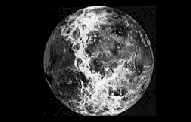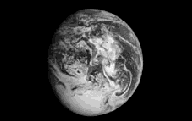
Produced by the Magellan mission in 1990, this false-color image of Venus maps the surface of Venus below the clouds.
Venus
Venus, the second planet in the solar system, is known throughout history as both the evening and the morning star. Venus is Earth's closest planetary neighbor and is similar to Earth in size, mass, composition, and distance from the Sun. Its scorching surface temperature of about 484°C could melt lead. The planet's atmosphere consists mainly of carbon dioxide with persistent sulfuric acid clouds. This atmosphere is extremely dense, exerting 90 times more pressure on Earth than Earth's atmosphere does.Venus rotates in a direction opposite of Earth, which means that if you were standing on Venus, you would see the Sun rising in the west and setting in the east. The planet rotates sluggishly. In fact, a "day" on Venus (243 Earth days) lasts longer than a Venus year, which lasts 225 Earth days.
The Magellan spacecraft mapped 98 percent of the planet revealing a surface consisting of 27 percent lowlands, 65 percent rolling plains, and 8 percent highlands. At least 85 percent of Venus is covered by volcanic rock--mostly lava flows that form the planet's vast plains. Mountains deformed by repeated geologic activity cover much of the remaining surface areas, some stretching 11 km high over the plains. The density of craters formed by the impact of asteroids and comets, at about two craters per million square km, is lower than densities of craters on the Moon or Mars. In fact few craters are smaller than about 25 km in diameter because of the shielding effect of Venus's dense atmosphere. The atmospheric pressure completely crushes and destroys any small meteorites with diameters of less than 1.5 km that pass through the atmosphere.

Galileo took this image of Earth showing South America and Antarctica in 1990 at a distance of 2 million km.
Earth
Earth is the third planet from the Sun, the fifth largest planet in the solar system, and the only planet known to harbor life. Earth's diameter is just a few hundred kilometers larger than that of Venus. We experience the planet's rotation as the daily routine of sunrise and sunset, while the four seasons result from Earth's axis of rotation being tilted more than 23 degrees. Our planet's rapid spin and molten nickel-iron core give rise to a magnetic field, which the solar wind distorts into a teardrop shape.An ocean of air that consists of 78 percent nitrogen, 21 percent oxygen, and 1 percent other constituents envelops the surface of the planet. This atmosphere shields us from nearly all harmful radiation coming from the Sun, and protects us from meteors as well--most of which burn up before they can strike the surface.
The North American continent continues to move west over the Pacific Ocean basin, roughly at a rate equal to the growth of our fingernails. We are made aware of this movement when it is interrupted by earthquakes. Scientists noticed a distinctive pattern to those earthquakes, leading them to conclude that Earth is dynamic, with its surface separated into moving caps or plates. Earthquakes result when plates grind past one another, ride up over one another, collide to make mountains, or split and separate. These movements are known as plate tectonics.
Oceans at least 4 km deep cover nearly 70 percent of Earth's surface. Water exists in the liquid phase only within a narrow temperature span (0 to 100°C). This temperature span is especially narrow when contrasted with the full range of temperatures found within the solar system. Water vapor in the atmosphere is responsible for much of Earth's weather.